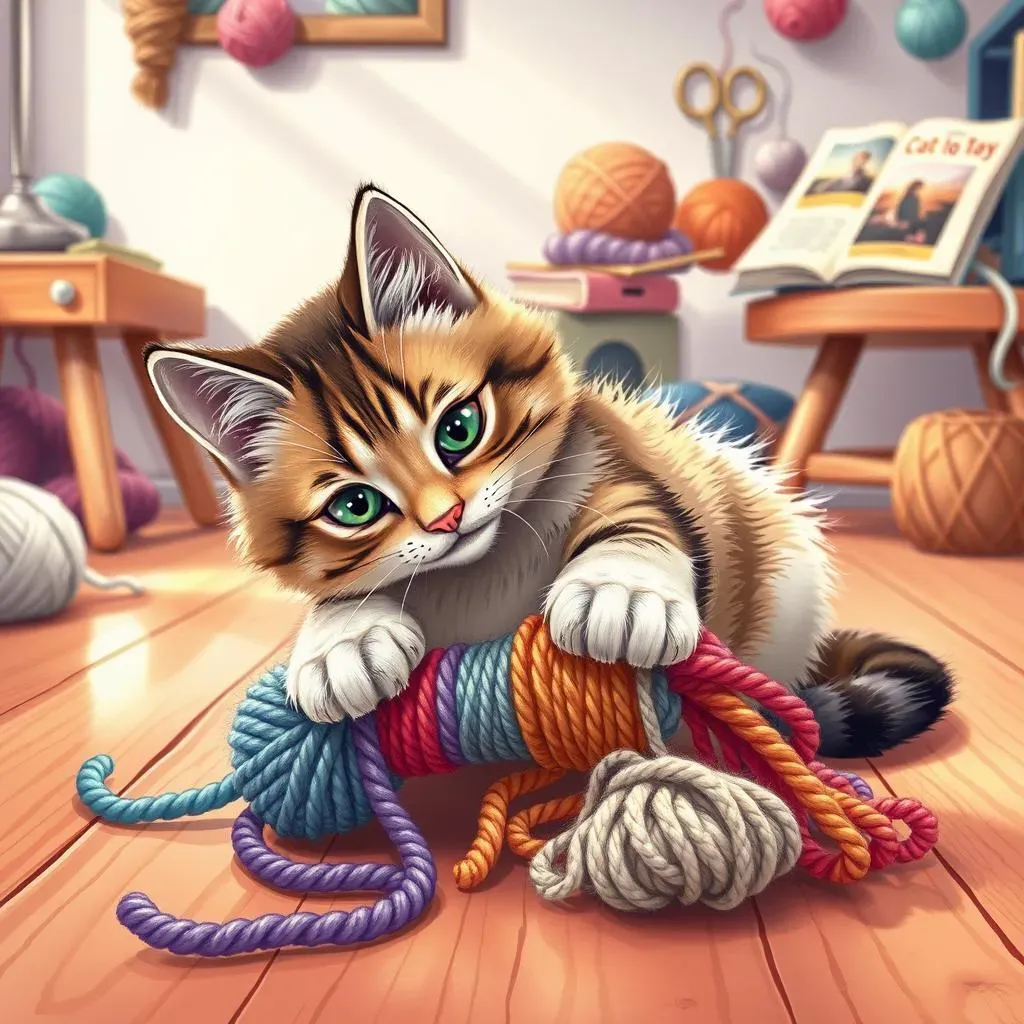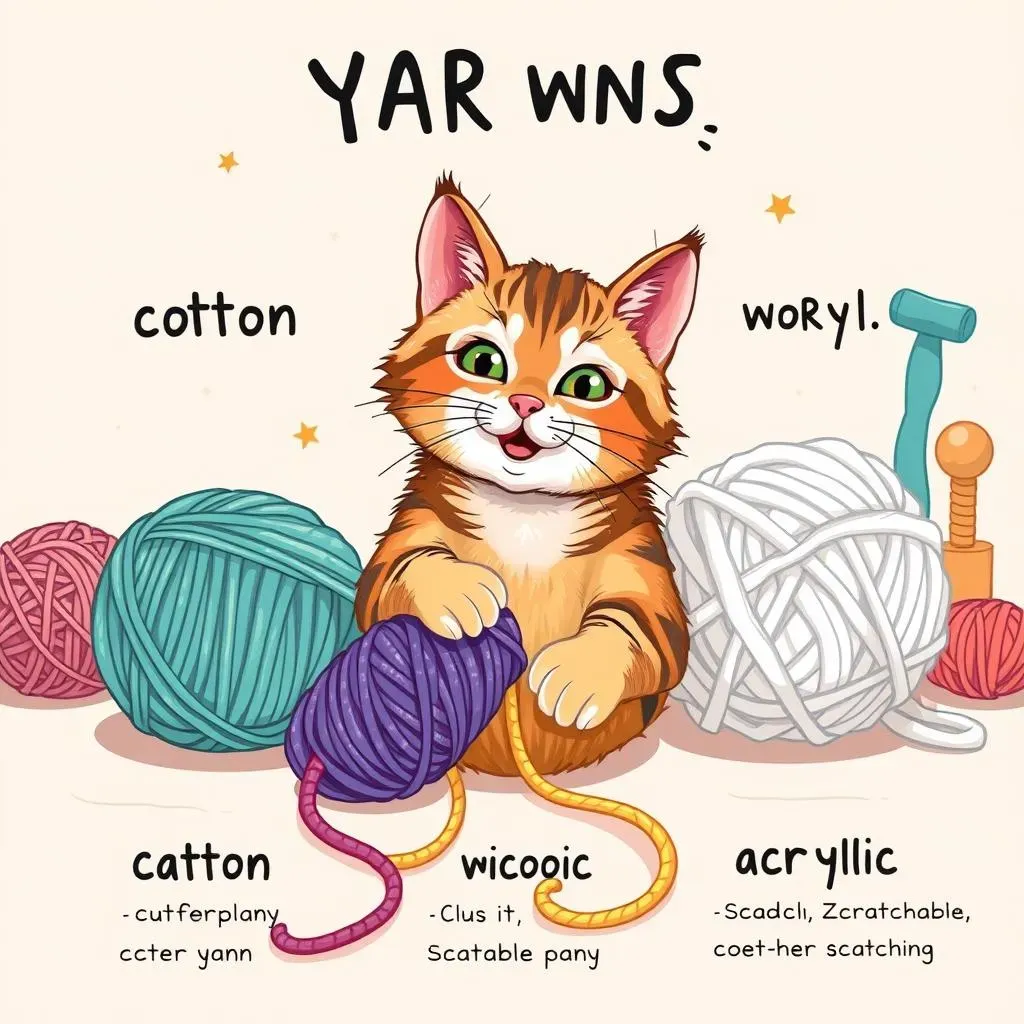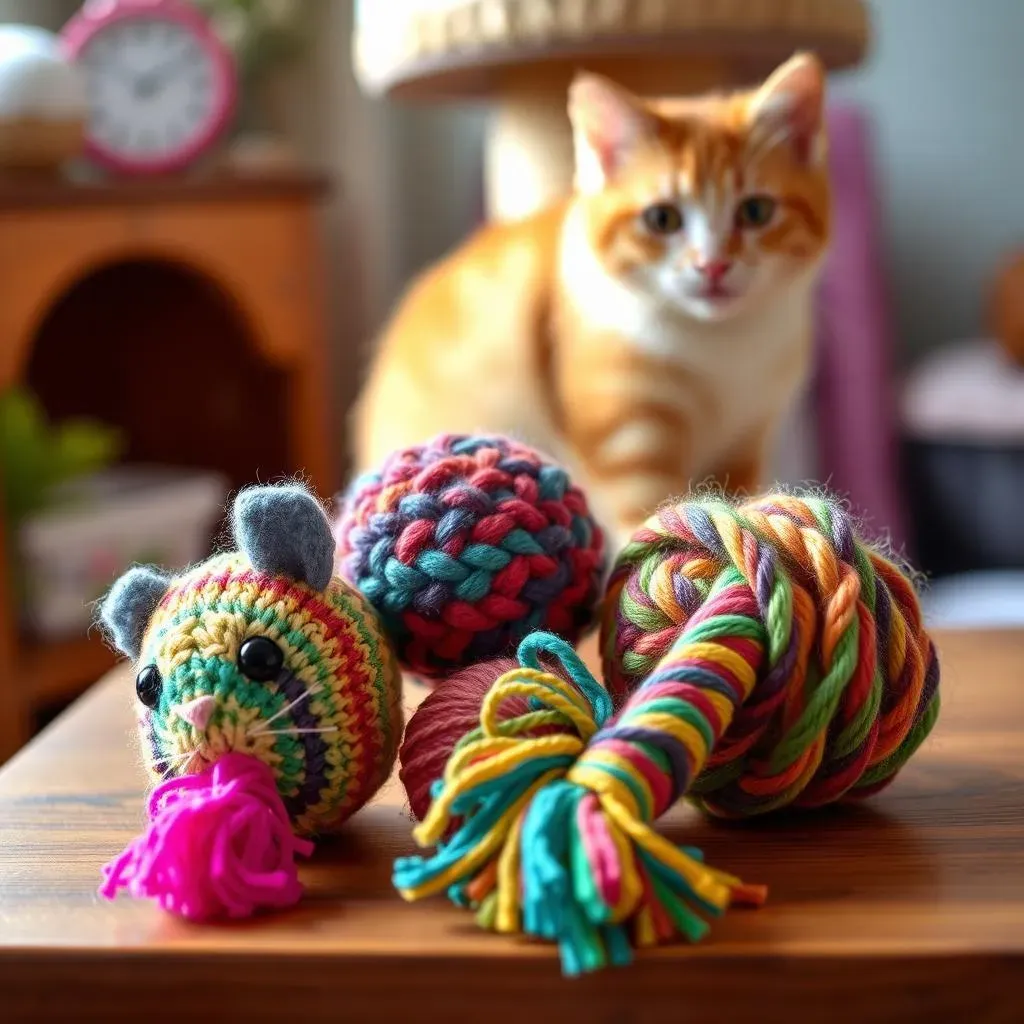Table of Contents
Ever wondered what makes a cat toy truly irresistible? It often comes down to the materials used, and when it comes to crafting your own feline fun, selecting the best yarn for cat toys is key. But with so many options out there, how do you choose? Is it all about softness, durability, or safety? This article is your comprehensive guide to navigating the world of yarn for cat toys, ensuring your furry friend gets the safest and most enjoyable playtime possible.
Why Choosing the Right Yarn Matters for Cat Toys

Why Choosing the Right Yarn Matters for Cat Toys
Safety First: Avoiding Harmful Materials
so you're thinking about making some toys for your feline friend? Awesome! But before you grab just any old skein, let's talk safety. Cats explore the world with their mouths, and that includes their toys. That means the yarn you choose could end up being ingested. Some yarns contain nasty chemicals or small parts that could be choking hazards. You definitely want to avoid anything with glitter, beads, or loosely attached embellishments. And steer clear of yarns treated with mothproofing chemicals or dyes that aren't pet-safe. Trust me, a little research upfront can save you a vet bill (and a lot of worry) later on.
Durability and Playtime Longevity
We all know how enthusiastic cats can get during playtime. Those claws and teeth can really put a toy through its paces! That's why durability is a major factor when choosing yarn. A flimsy yarn will quickly unravel, leaving you with a pile of fluff and a disappointed kitty. Opt for yarns that can withstand some serious batting, kicking, and chewing. Natural fibers like cotton and wool are generally more durable than some of the cheaper synthetics. Plus, a longer-lasting toy means less time spent repairing or replacing it – more time for cuddles!
Texture and Engagement: Keeping Your Cat Interested
Think about what textures your cat enjoys. Do they love scratching at sisal, batting at feathers, or snuggling with soft plush? The texture of the yarn plays a big role in how engaged your cat will be with their new toy. Some cats prefer the feel of natural fibers, while others are drawn to the bounciness of acrylic. Experiment with different textures to see what piques your cat's interest. You can even combine different yarns to create a multi-sensory toy that will keep them entertained for hours. Just remember to prioritize safety above all else – no matter how enticing the texture, it shouldn't compromise your cat's well-being.
Yarn Type | Durability | Safety | Texture |
|---|---|---|---|
Cotton | Medium | High | Soft, absorbent |
Wool | High | Medium (check for allergies) | Warm, slightly scratchy |
Acrylic | Low to Medium | Medium (choose pet-safe) | Smooth, bouncy |
Top Yarn Types for Safe and Engaging Cat Toys

Top Yarn Types for Safe and Engaging Cat Toys
Cotton Yarn: Softness and Safety Combined
Cotton yarn is a fantastic choice for cat toys, especially for kittens or cats with sensitive skin. It's incredibly soft, making it perfect for snuggling and gentle play. Plus, cotton is a natural fiber, so it's less likely to cause allergic reactions. Look for organic cotton options to minimize exposure to harmful chemicals. One thing to keep in mind is that cotton can absorb moisture, so it might not be the best choice for toys that are constantly being drooled on. But for soft, safe, and cuddly toys, cotton is a winner!
I made a little cotton mouse for my friend's kitten, and she absolutely loves it! She carries it around everywhere and even sleeps with it. It's so rewarding to see her enjoying something I made with my own hands, knowing that it's safe and comfortable for her.
Wool Yarn: Durable and Engaging Texture
Wool yarn is another excellent natural fiber option, known for its durability and slightly scratchy texture that many cats find irresistible. It's also naturally flame-resistant, which adds an extra layer of safety. However, some cats can be allergic to wool, so it's always a good idea to test a small sample before making a whole toy. Wool is also a bit more expensive than cotton or acrylic, but its longevity and engaging texture make it a worthwhile investment. Just be sure to hand wash wool toys to prevent shrinkage.
My cat, Whiskers, is obsessed with anything wool. I once knitted him a little wool ball, and he chased it around the house for hours. The slightly rough texture seemed to really stimulate his hunting instincts, and he loved sinking his claws into it (much to my dismay, but hey, he was happy!).
Acrylic Yarn: Budget-Friendly and Versatile
Acrylic yarn is a synthetic option that's popular for its affordability and wide range of colors. It's also machine washable, which is a huge plus for busy cat owners. However, not all acrylic yarns are created equal. Some cheaper options can be scratchy or contain harmful chemicals. Look for acrylic yarns that are specifically labeled as "pet-safe" or "baby-safe" to ensure they're free from toxins. Also, acrylic yarn tends to pill more easily than natural fibers, so be prepared to do some occasional maintenance to keep your cat's toys looking their best.
Acrylic yarn is my go-to for larger projects, like catnip-filled kickers. It's budget-friendly, so I don't feel bad when Whiskers inevitably destroys them. Plus, the bright colors really catch his eye, making playtime even more exciting.
DIY Cat Toy Projects: Yarn Selection and Safety Tips

DIY Cat Toy Projects: Yarn Selection and Safety Tips
Simple Knitted Mice: A Beginner's Delight
Ready to get crafty? One of the easiest DIY cat toy projects is a simple knitted mouse. All you need is some yarn (cotton or pet-safe acrylic are great choices), knitting needles, stuffing (catnip optional!), and a bit of creativity. Cast on a few stitches, knit a small rectangle, and then seam it up to form a tube. Cinch one end closed for the nose, stuff it with your filling of choice, and then cinch the other end for the tail. You can even add some yarn whiskers for extra cuteness! Remember to knot the yarn ends securely and trim any excess to prevent your cat from swallowing them.
When I first started knitting cat toys, my mice looked… well, let's just say they were more abstract art than realistic rodents. But Whiskers didn't seem to mind! He batted them around with just as much enthusiasm as the store-bought ones. The key is to have fun and not be afraid to experiment. And always prioritize safety – no small parts, secure knots, and pet-safe materials are a must!
- Yarn Choice: Cotton or pet-safe acrylic
- Stuffing Options: Catnip, fiberfill, or even dried rice for a crinkly sound
- Safety Check: Secure knots, trimmed ends, no small parts
Crocheted Catnip Balls: A Sensory Explosion
If you're a crochet enthusiast, catnip balls are another fantastic project. Using a simple crochet stitch (like single crochet), create a small sphere. Before closing it up, stuff it generously with catnip. The texture of the crochet combined with the irresistible scent of catnip will drive your kitty wild! You can also experiment with different yarn colors and textures to make each ball unique. Just be sure to use a tight stitch to prevent the catnip from spilling out.
I once made a batch of catnip balls using different shades of green and brown yarn. Whiskers went absolutely bonkers! He rolled around with them, tossed them in the air, and even tried to bury them in his food bowl. It was hilarious to watch him so completely enthralled by something I had created. And knowing that he was enjoying a safe and stimulating toy made it even more rewarding.
Project | Yarn Type | Skill Level | Safety Considerations |
|---|---|---|---|
Knitted Mouse | Cotton or Acrylic | Beginner | Secure knots, trimmed ends |
Crocheted Catnip Ball | Cotton or Wool | Beginner | Tight stitch, pet-safe catnip |
Braided Yarn Teaser: Interactive Fun
For a more interactive toy, try making a braided yarn teaser. Cut several strands of yarn (different colors and textures can add interest) and braid them together tightly. Secure the ends with knots or by wrapping them with extra yarn. Attach the braid to a stick or dowel rod for easy handling. This toy is perfect for interactive play, allowing you to mimic the movements of prey and engage your cat's hunting instincts. Just be sure to supervise your cat during playtime and put the toy away when you're not around to prevent them from chewing on the stick.
One of Whiskers' favorite games is chasing the braided yarn teaser. I love watching him stalk, pounce, and bat at the braid like a little tiger. It's a great way for him to get exercise and burn off some energy, and it's also a fun way for us to bond. Just remember to keep the play sessions short and sweet to prevent him from getting bored or overstimulated.
Beyond Yarn: Other Materials to Enhance Your Cat Toys

Beyond Yarn: Other Materials to Enhance Your Cat Toys
Crinkle Material: Adding Auditory Stimulation
Let's be honest, sometimes yarn alone just doesn't cut it. Cats are complex creatures with diverse needs! That's where other materials come in. One of my favorites is crinkle material. You know, that stuff that makes a satisfying rustling sound when you crumple it? Cats go wild for it! You can easily incorporate crinkle material into your yarn-based toys to add an extra layer of auditory stimulation. Simply cut a piece of crinkle material (mylar or cellophane works well), stuff it inside the toy along with your filling, and watch your cat's ears perk up. It's a surefire way to make playtime more engaging and exciting.
I once made a batch of crinkle balls for a local animal shelter, and the kittens went absolutely nuts for them. They chased them, pounced on them, and even tried to shred them (which, admittedly, wasn't ideal, but hey, they were having fun!). The crinkle sound seemed to really capture their attention and keep them entertained for hours. It's a simple addition that can make a huge difference in a cat's enjoyment of their toys.
Feathers and Faux Fur: Tapping into Hunting Instincts
If you really want to unleash your cat's inner predator, consider adding feathers or faux fur to your yarn creations. Feathers mimic the movement of birds, triggering your cat's hunting instincts and encouraging them to stalk, chase, and pounce. Faux fur, on the other hand, provides a soft and satisfying texture that cats love to rub against. You can attach feathers to the end of a yarn teaser, create a faux fur mouse, or even combine the two for the ultimate sensory experience. Just be sure to use high-quality feathers that won't easily break or shed, and opt for faux fur that's free from harmful chemicals.
My cat, Luna, is obsessed with feathers. I once tied a few feathers to the end of a yarn string, and she spent the entire afternoon chasing it around the house. She would stalk it from behind furniture, pounce on it with lightning speed, and then proudly parade around with her "prey" in her mouth. It was amazing to see her so completely engrossed in the game. And I knew that I was providing her with a safe and stimulating outlet for her natural hunting instincts.
Material | Benefit | Safety Considerations |
|---|---|---|
Crinkle Material | Auditory Stimulation | Ensure it's securely enclosed |
Feathers | Taps into Hunting Instincts | Use high-quality, durable feathers |
Faux Fur | Soft and Satisfying Texture | Choose pet-safe, chemical-free options |
Crafting Happiness: The Final Thread on Choosing the Best Yarn for Cat Toys
Selecting the best yarn for cat toys doesn't have to be a daunting task. Armed with the knowledge of different yarn types, safety considerations, and a little DIY inspiration, you can create a treasure trove of engaging and safe toys for your feline friend. Remember, the goal is to provide enrichment and joy while prioritizing your cat's well-being. So, grab your needles, choose your yarn wisely, and get ready to unleash your inner craftsperson – your cat will thank you for it with endless purrs and playful pounces!